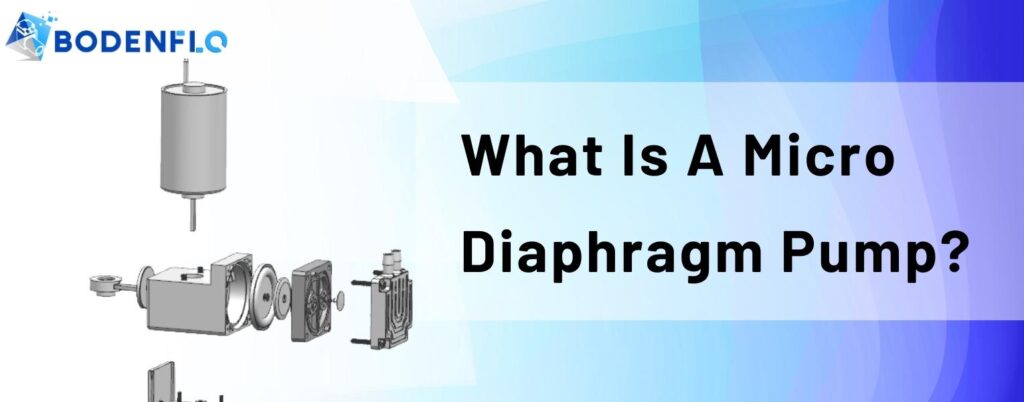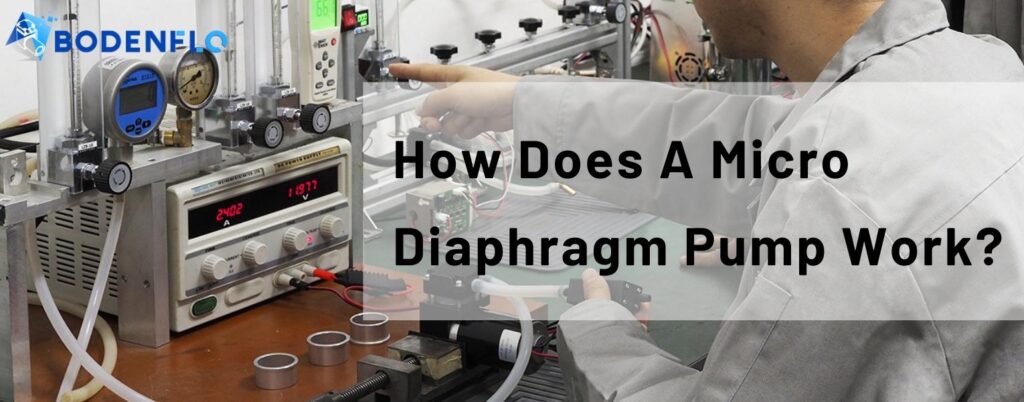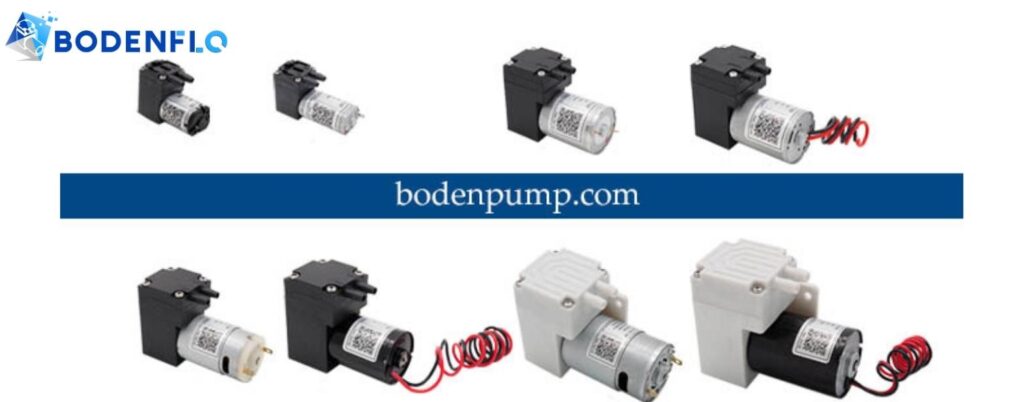
You've likely stumbled upon this post because you have a problem that needs solving. Maybe you're looking to move fluids in a precise manner, and your current solution just isn't cutting it. Or perhaps you're delving into a new project requiring a pump that's small, efficient, yet powerful.
A Micro Diaphragm Pump is an essential tool for the precise management of both gases and liquids in applications that demand high efficiency and versatility within a compact design. This pump excels in delivering accurate fluid movement, whether under pressure or vacuum, making it an ideal choice for space-constrained yet performance-critical environments.
Stick around, because I'm about to dive deep into the nitty-gritty of Micro Diaphragm Pumps and why you should care..
What is a Micro Diaphragm Pump?
A micro diaphragm pump is a highly adaptable and compact device engineered for the movement of various fluids, including gases and liquids. It operates via a motor-driven eccentric wheel that actuates the diaphragm, inducing a reciprocating motion. This motion is critical for the pump's functionality, as it causes the volume within the pump chamber to change in a rhythmic pattern. Such a mechanism is key to the pump's ability to efficiently and continuously intake and expel both gases and liquids.
Core Functional Attributes:
- Dual Functionality: It is adept at generating both pressure and vacuum, enhancing its utility across diverse applications.
- Fluid Handling Flexibility: The pump efficiently handles a wide spectrum of fluids, accommodating different properties such as viscosity and corrosive nature.
- Controlled Fluid Movement: The reciprocating action of the diaphragm provides precise control over the displacement of gases and liquids, a vital feature for precision-driven tasks.
Advantages:
- Compact and Efficient Design: Its small footprint combined with high operational efficiency makes it ideal for use in space-limited environments.
- Consistent and Reliable Operation: Built to endure, these pumps offer consistent performance, even under prolonged usage.
- Versatility: The capability to manage both gases and liquids broadens its application range significantly.
The miniature diaphragm pump stands as a critical component in modern fluid management systems, offering unmatched precision and versatility for handling both gases and liquids in a wide array of advanced applications.
How Does a Micro Diaphragm Pump Work?
Micro diaphragm pumps are cornerstones in precision fluidic solutions, lauded for their compact size and precise operation. Allow me to delve into the operating principles that make these DC motor-driven pumps a go-to for many industry professionals.

The heart of a micro diaphragm pump is a DC motor. This motor drives a reciprocating diaphragm, commonly made of durable, chemical-resistant materials like PTFE or EPDM. A set of check valves, one for intake and one for discharge, work in harmony with the diaphragm's movements to enable fluid flow.
The operation is elegantly simple yet incredibly effective:
- Suction Phase: When the diaphragm retracts, it creates a low-pressure zone within the chamber. This opens the intake check valve, pulling the fluid into the chamber.
- Discharge Phase: As the diaphragm moves forward, the fluid in the chamber is pressurized. This causes the discharge check valve to open, expelling the fluid out of the chamber.
This diaphragm movement is directly controlled by the DC motor, which can be finely tuned to meet specific flow rate and pressure requirements. One distinct advantage of using a DC motor is the power efficiency, especially when high torque is not a primary requirement. Furthermore, DC motors allow for simpler speed controls, facilitating a wide range of flow rates and operational modes.
Micro diaphragm pumps are inherently self-priming and can run dry without damage. This makes them extremely reliable and versatile, suitable for applications ranging from medical devices to environmental monitoring equipment.
In conclusion, DC motor-driven micro diaphragm pumps are compact, efficient, and customizable, designed to meet the exacting needs of diverse fluid handling applications. Their simplicity belies their versatility, making them an invaluable resource in any engineer's toolkit.
What Are the Key Components?

- Diaphragm: This is the heart of the pump. Typically made from high-grade materials like PTFE or EPDM, the diaphragm is engineered for resilience and chemical resistance. Its primary function is to oscillate, moving the fluid from one chamber to another. The material choice often depends on the application, and it has to offer both flexibility and durability.
- DC Motor: An essential aspect that is sometimes overlooked is that these pumps are generally driven by Direct Current (DC) motors. DC motors offer an advantage in terms of efficiency and precise control. They also allow for a more compact design, which is pivotal for applications where space is a premium.
- Eccentric: This component is directly coupled to the DC motor's shaft. It's essentially an off-center cam that converts the motor's rotational movement into the reciprocating oscillation that drives the diaphragm. The eccentric's role is crucial in determining both the amplitude and frequency of the diaphragm's movement. Its design and position are meticulously calculated to ensure optimum fluid flow, all while minimizing wear and tear on the diaphragm and motor. The eccentric works in harmony with the diaphragm, valves, and DC motor to create a finely tuned pumping system. The synchrony between the eccentric and the other core components directly impacts the pump's efficiency, reliability, and longevity.
- Inlet and Outlet Valves: Often, these are designed as one-way check valves, crucial for controlling the direction of fluid flow. The inlet valve opens during the suction phase, while the outlet valve facilitates the discharge phase. Typically made from materials resistant to chemical corrosion, these valves ensure that the fluid only goes in the intended direction.
- Motor Controller: For applications requiring high precision, a separate motor controller can be included. This unit precisely manages the motor speed, offering an adjustable and highly accurate flow rate, thus catering to specialized needs.
- Housing: Last but not least, the outer housing provides the structural integrity to house all these components. Usually crafted from robust materials like stainless steel or high-grade plastic, the housing also often provides some level of sound insulation and chemical resistance.
What Are the Applications of a Micro Diaphragm Pump?
- Medical Field: Think of respiratory devices, portable dialysis machines, and precise dosing in drug delivery systems. The need for high precision and reliability makes micro diaphragm pumps indispensable in medical applications.

- Analytical Instruments: Gas chromatography, air quality monitoring, and fluid sampling often require the accurate and consistent flow rates that these pumps can provide.
- Water Treatment: These pumps are often utilized for chemical dosing in water treatment facilities. They deliver the exact amount of chemical—no more, no less—to keep water safe and clean.
- Food and Beverage: From beverage dispensers to automated cooking appliances, the culinary world benefits from the precise fluid control offered by micro diaphragm pumps.
- Automotive: Believe it or not, these pumps are also employed in various automotive applications, such as in braking systems, where precise control of hydraulic fluids is necessary.
- Industrial Automation: In environments where consistency and precision are key, such as in the dosing of adhesives or coolants, micro diaphragm pumps are frequently the go-to solution.
- Consumer Electronics: Yes, even your home coffee machine might have a micro diaphragm pump to ensure that the water pressure is just right for your morning espresso.
To sum it up, the application of micro diaphragm pumps is far-reaching, encompassing areas that affect our daily lives in ways we may not even be aware of. Their accuracy, reliability, and ability to work in a variety of conditions make them an essential component in modern technology across multiple sectors.
Why Choose a Micro Diaphragm Pump Over Other Types?
When it comes to selecting a pumping solution, the choice is often more complicated than one might initially think. However, there are compelling reasons why one might opt for a micro diaphragm pump over other types.
- Compact Design: One of the most striking advantages is the small form factor. These pumps are designed for tight spaces without compromising on efficiency, making them ideal for portable devices and compact machinery.

- Precision: With applications in the medical, laboratory, and analytical fields, accuracy is non-negotiable. Micro diaphragm pumps deliver precise flow rates and accurate dosing, ensuring that you get the exact outcome you desire.
- Energy Efficiency: When compared to other pumps like peristaltic or piston pumps, the energy efficiency of a micro diaphragm pump is often superior. The design is optimized to consume less power while delivering excellent performance.
- Ease of Maintenance: These pumps have fewer moving parts, meaning less wear and tear, and subsequently, less downtime for maintenance. This adds to the operational efficiency and longevity of the system.
- Compatibility: Micro diaphragm pumps can handle a diverse range of media including air, gases, and liquids, making them versatile across a wide array of applications.
- Noise Levels: Particularly in settings like medical facilities or laboratories, noise can be an important factor. These pumps often operate at lower noise levels compared to other types.
- Cost: While the initial investment might be relatively higher, the total cost of ownership often turns out to be lower due to less frequent maintenance and longer life cycles.
In summary, the micro diaphragm pump offers a compelling mix of compactness, precision, and efficiency, making it a go-to choice for applications where these attributes are paramount. It strikes a remarkable balance between performance and practicality, often outclassing alternative options.
How to Select the Right Micro Diaphragm Pump?
selecting the right micro diaphragm pump is crucial for the efficiency and effectiveness of your specific application. Here's how to navigate this complex decision:
- Fluid Type: The first step is understanding the type of fluid you'll be working with. Is it a liquid or a gas? Is it corrosive or neutral? The material of the diaphragm and the pump housing should be compatible with the fluid.
- Operating Pressure: Different applications require different pressure levels. Always check the maximum and minimum operating pressures of the pump to ensure it suits your application's needs.
- Flow Rates: Know the required flow rate for your application. Is it a constant or variable flow? Ensure the pump can handle these rates efficiently.
- Power Source: Ensure that the power source is compatible with the pump. Whether it's electric or battery-operated, the power source should meet the pump's requirements for optimal functionality.
- Customization: One size does not fit all. Work with an OEM that can customize the pump's features to meet your specific needs. At BODENFLO, we offer parametric customizable pumps to ensure you get a pump tailored to your exact requirements.
- Certification and Compliance: Ensure the pump complies with the necessary industry standards and certifications. This is especially important in regulated sectors like healthcare or food and beverage.
- Expert Consultation: Lastly, never underestimate the value of expert advice. Whether you're a procurement officer or a distributor, consulting with a subject matter expert can offer invaluable insights into selecting the ideal pump.
In summary, selecting the right micro diaphragm pump is a meticulous process that involves various considerations. By paying attention to these factors and consulting experts, you're well on your way to making an informed and effective choice.
Are They Easy to Maintain?
Absolutely, ease of maintenance is one of the standout features of micro diaphragm pumps. One of the prime reasons for this is the fewer moving parts, which not only reduces wear and tear but also decreases the likelihood of operational hiccups. The diaphragm is the main component that may require periodic replacement, but it's usually a simple procedure.
Now, although these pumps are designed for durability, it's imperative to adhere to the manufacturer's maintenance guidelines. Regularly scheduled inspections should be a part of your maintenance routine. During these inspections, check the diaphragm for wear and tear, examine the valves for any debris, and ensure the motor is functioning correctly.
For those who prioritize efficiency and minimal downtime—be it procurement officers, distributors, or end-users—micro diaphragm pumps are a blessing. Not only are they robust and reliable, but their straightforward maintenance also means that they're less likely to be the cause of operational delays. That's what we aim for in the design and manufacture of our micro diaphragm pumps at BODENFLO: optimal performance with minimal fuss.
Conclusion
Micro Diaphragm Pump is a compact, efficient, and versatile piece of equipment that should be on your radar if you're in the business of moving fluids precisely. Trust me, investing in a good quality Micro Diaphragm Pump is worth every penny, especially if you customize it to your specific needs.

When it comes to customization and top-notch quality, BODENFLO is your go-to source. We specialize in parametric customizable pumps, ideal for high pressure, vacuum, and flow requirements. Don't just take my word for it—experience the efficiency and reliability of our micro diaphragm pumps for yourself. Visit our website or contact us today to discuss how we can fulfill your specific pumping needs. Your success is our business.


